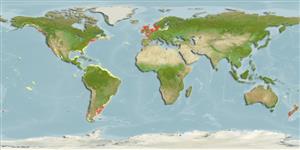Common names from other countries
Classification / Names / Names
Nomes comuns | Sinónimos | Catalog of Fishes (gen., sp.) | ITIS | CoL | WoRMS
Environment: milieu / climate zone / depth range / distribution range
Ecologia
; intervalo de profundidade 0 - 55 m (Ref. 83939). Subtropical
Atlantic Ocean, Pacific Ocean and the Mediterranean.
Length at first maturity / Tamanho / Peso / Idade
Maturity: Lm ? range ? - ? cm Max length : 10.0 cm TL macho/indeterminado; (Ref. 402)
Life cycle and mating behavior
Maturidade | Reprodução | Desova | Ovos | Fecundidade | Larvas
Members of the phylum Phoronida are mostly hermaphroditic. Life cycle: Embryos develop into free-swimming planktotrophic actinotrocha larvae which later sinks to the bottom and metamorphose into benthic adults.
Hansson, H.G. 1999. (Ref. 997)
Categoria na Lista Vermelha da IUCN (Ref. 130435: Version 2024-1)
Categoria CITES (Ref. 108899)
Not Evaluated
Not Evaluated
Utilização humana
| FishSource |
Ferramentas
Mais informação
Nomes comunsSinónimosPredadoresReproduçãoMaturidadeDesovaFecundidadeOvosDesenvolvimento dos ovos
Idade/Tamanho
Crescimento
Comprimento-peso
Comprimento-comprimento
Morfologia
Larvas
Abundância
Fontes da internet
Estimates based on models
Preferred temperature
(Ref.
115969): 8.6 - 15.8, mean 10.7 (based on 560 cells).
Vulnerabilidade
Low vulnerability (10 of 100).
Categoria de preço
Unknown.
